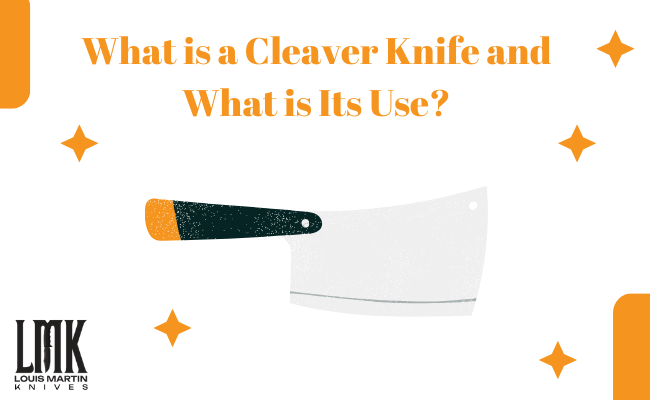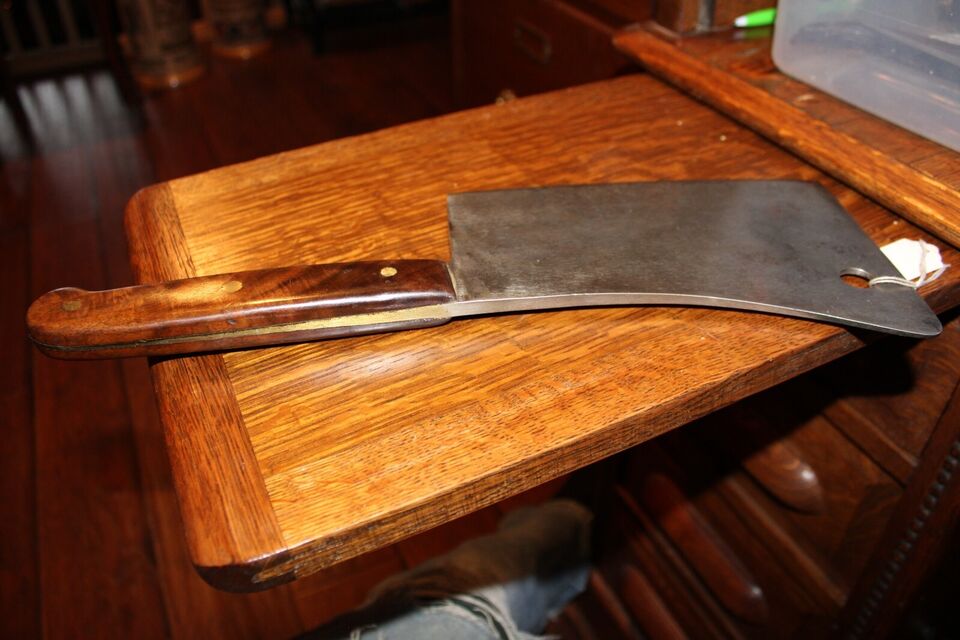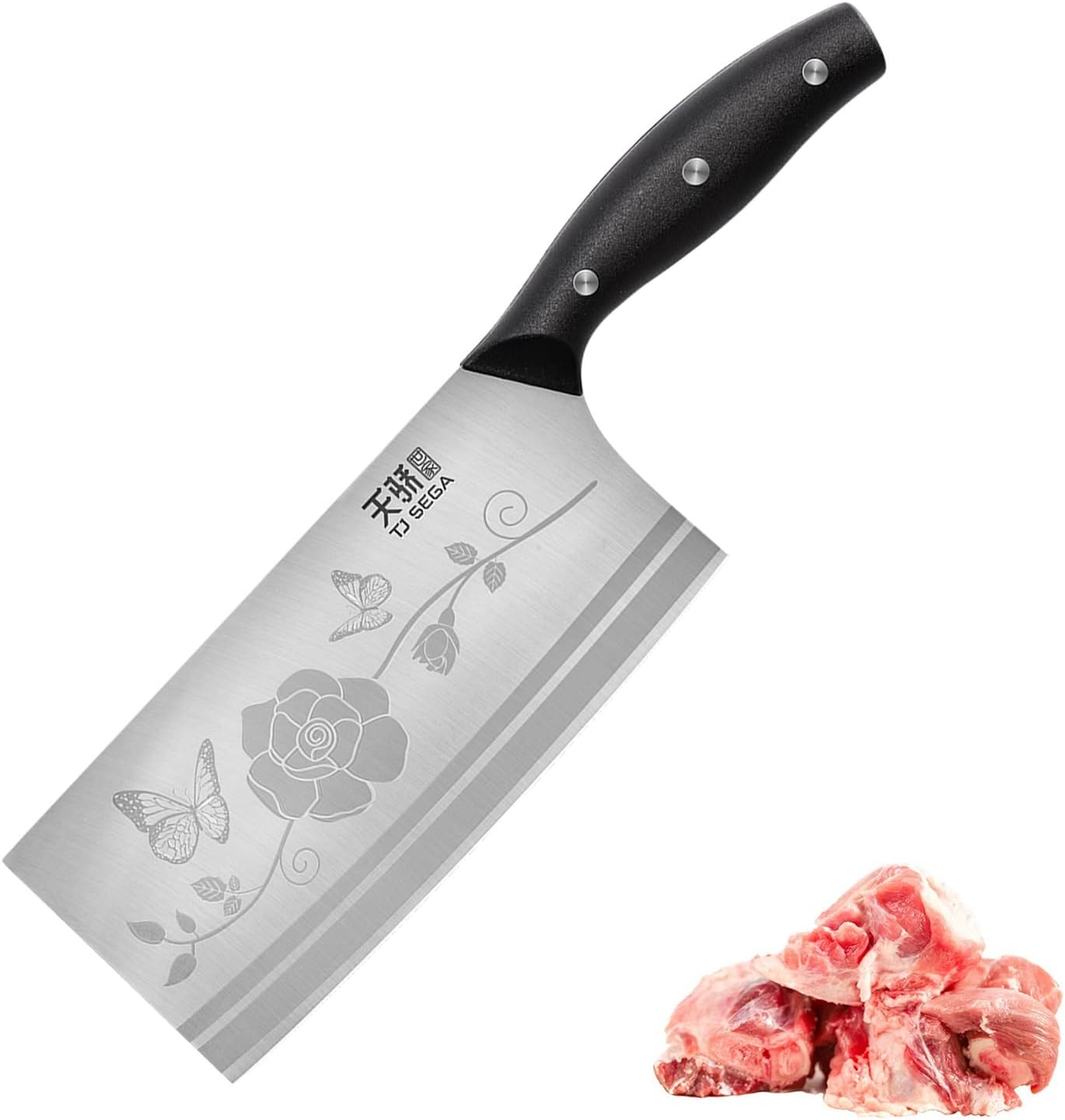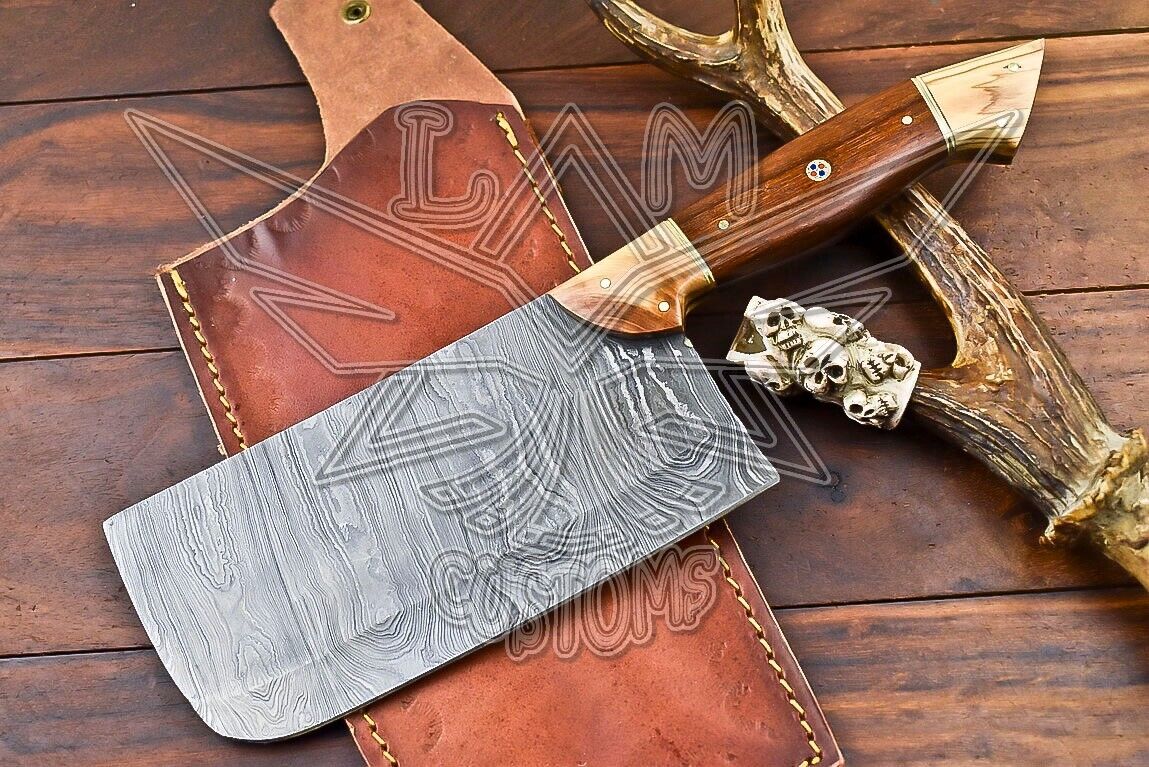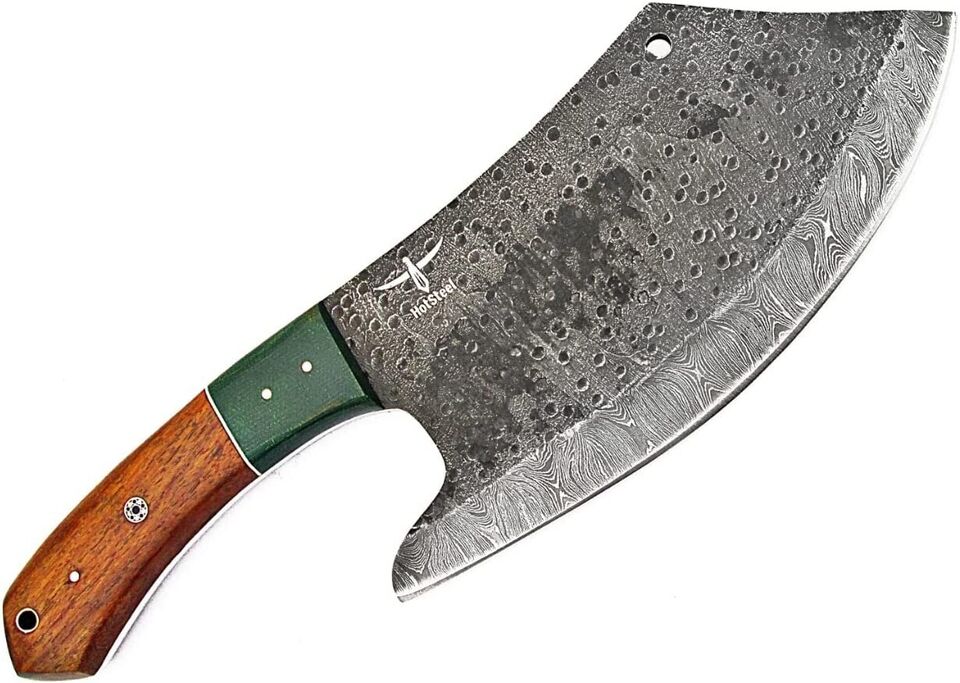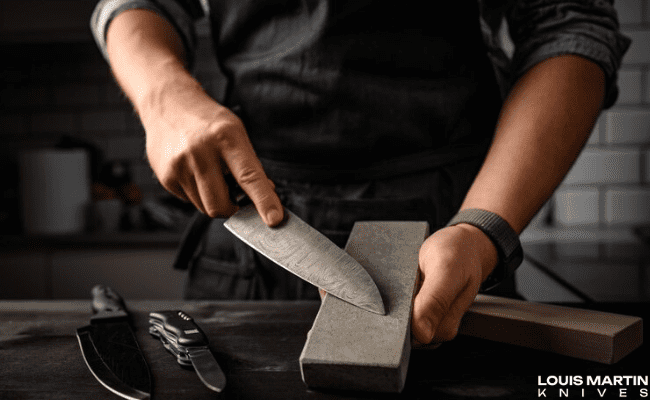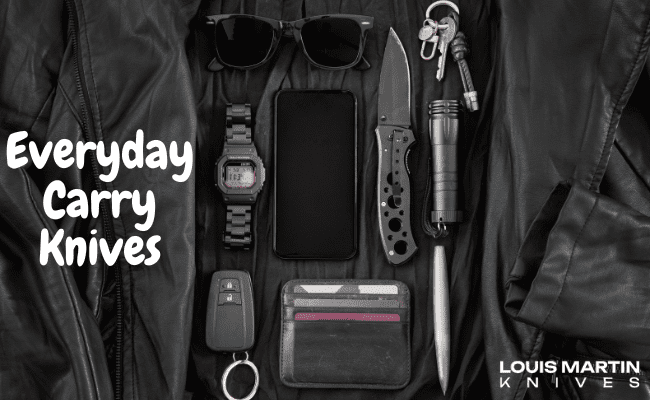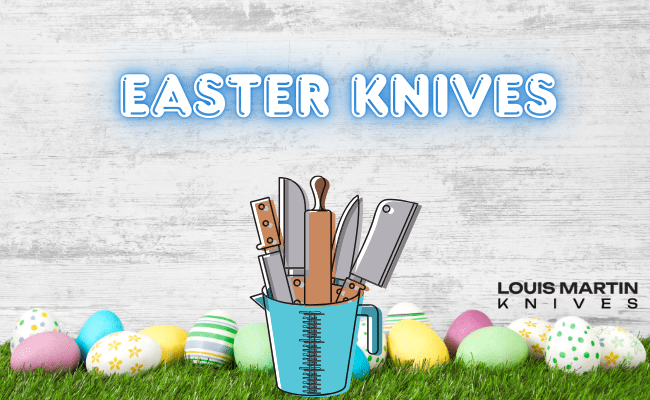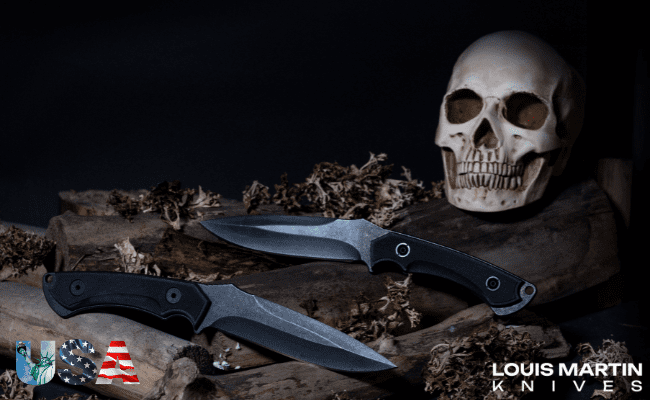A cleaver knife, a stalwart in the kitchen, is a multifunctional tool that often takes center stage during culinary adventures. But what exactly is a cleaver knife, and why is it crucial to grasp its diverse applications? A flavorful journey through the world of cleaver knives.
Handmade knives exemplify craftsmanship and attention to detail. These unique creations showcase the artistry and skill of the maker, providing a personalized touch to kitchen essentials or collectible blades.
Definition of a Cleaver Knife
A cleaver knife is a distinctive kitchen blade characterized by a broad, rectangular blade and a hefty build. This knife’s distinguishing features set it apart from its more slender counterparts. Its blade, typically made of high-quality stainless steel, showcases a robust construction that allows it to tackle a variety of tasks with precision.
Importance of Understanding Its Use
Understanding the purpose and potential of a cleaver knife is akin to unlocking a chef’s secret weapon. This kitchen essential serves as a culinary chameleon, seamlessly transitioning between different tasks to streamline food preparation. From slicing and chopping to deboning, a cleaver knife’s versatility makes it indispensable in the hands of both professional chefs and home cooks.
History of Cleaver Knives
Delving into the history of cleaver knives unveils a fascinating journey that spans centuries, marked by evolution, cultural significance, and a lasting impact on culinary traditions.
Origins and Evolution
The roots of cleaver knives can be traced back to ancient times when early civilizations sought tools for various tasks, including food preparation. The evolution of cleavers mirrors the ever-changing needs and culinary techniques of diverse cultures. From the simple, utilitarian designs of ancient China to the refined craftsmanship of modern Western cleavers, these knives have adapted to meet the demands of different cuisines and cooking styles.
As culinary practices evolved, so did a cleaver knife. The earliest cleavers were likely fashioned from stone or bone, gradually evolving into the metal blades we recognize today. The wide, rectangular shape of the blade emerged to provide stability and control, essential for the diverse cutting and chopping tasks that a cleaver undertakes.
Cultural Significance
Beyond its practical utility, a cleaver knife carries profound cultural significance in various societies. In Chinese cuisine, for example, the cleaver is a symbol of skill and expertise in the kitchen. It’s not merely a tool but an extension of the chef knife artistry, capable of creating culinary masterpieces. Similarly, in Western cultures, the cleaver has become a staple in both professional and home kitchens, valued for its versatility in handling meats, vegetables, and more.
The cultural significance of cleaver knives extends beyond their functionality. They are embedded in traditions, rituals, and the very fabric of culinary heritage. As we explore the cultural dimensions of cleaver knives, we gain a deeper appreciation for their role in shaping the way we approach food preparation and cooking techniques. Stay tuned as we continue our exploration of the cleaver knife’s rich history and its impact on kitchens worldwide.
Anatomy of a Cleaver Knife
Unveiling the anatomy of a cleaver knife reveals a precision-crafted instrument designed for culinary prowess. Each element, from the blade to the handle and the carefully considered weight and size, plays a crucial role in defining the character and functionality of this kitchen essential.
Blade
The soul of any cleaver knife lies in its blade. Characterized by a broad, rectangular shape, the blade is the workhorse of the knife, facilitating efficient slicing, chopping, and dicing. Typically forged from high-quality stainless steel, a cleaver’s blade boasts durability and resilience. Its broad surface area provides stability, allowing for controlled cuts through a variety of ingredients. Whether it’s the finesse required for vegetable mincing or the robust strength needed for meat cleaving, the blade is the key player in the cleaver’s impressive repertoire.
Damascus Steel Fixed blade Chef Cleaver knife White
Handle
Nestled in the cook’s palm, the handle of a cleaver knife is a crucial ergonomic component. Crafted for comfort and control, the handle allows for a secure grip during intricate maneuvers. Often made from materials like wood, plastic, or composite materials, the handle complements the blade’s functionality. Its design considers factors such as balance and grip, ensuring that the chef can maneuver the cleaver with precision and ease.
A Cleaver Knife: Weight and Size
The weight and size of a cleaver knife contribute significantly to its versatility. A slightly heavier build imparts momentum, aiding in the cleaver’s chopping capabilities. The size of the blade determines the range of tasks the cleaver can handle, from large cuts of meat to fine mincing of herbs. Striking the right balance between weight and size is crucial, as it allows the cleaver to be adaptable to a myriad of culinary challenges.
Antique Meat Cleaver, 8″ blade village Blacksmith Watertown
Versatility in the Kitchen
As we witness a cleaver knife effortlessly navigate the diverse terrain of both meat and vegetable preparation, its status as a culinary workhorse becomes evident. It seamlessly transitions between tasks, embodying adaptability and precision, making it an invaluable asset for both professional chefs and home cooks alike. Stay tuned as we delve deeper into the nuances of choosing the right cleaver knife and unlocking its full potential in the kitchen.
As we explore the myriad tasks it can undertake, the true essence of a cleaver knife’s versatility in the kitchen comes to light.
Meat Preparation
A cleaver knife emerges as a stalwart companion in the realm of meat preparation, showcasing its prowess in various facets.
Meat Cleaver Knife 7.5 Inch
Slicing
When precision is paramount, the cleaver’s broad blade excels in creating uniform slices of meat. From succulent steaks to delicate fillets, the cleaver’s weight and design ensure each cut is made with finesse, enhancing the overall presentation of the dish.
Chopping
The cleaver’s heft and robust construction make it the go-to tool for chopping through bones and tougher cuts of meat. It brings efficiency to the kitchen, transforming the once laborious task of meat chopping into a seamless process.
Deboning
Navigating the intricate landscape of deboning requires precision and control, and the cleaver rises to the occasion. Its sharp edge maneuvers around bones with ease, allowing for clean and efficient deboning, whether it’s a whole chicken or a larger piece of meat.
Vegetable Preparation
The cleaver’s versatility extends beyond the realm of meat, making it an indispensable tool for vegetable preparation.
Fixed Blade Damascus Steel, Walnut Wood Clever Chopper Axe Knife Wooden Bolster
Dicing
Transforming vegetables into perfectly diced pieces requires a knife that can handle the task with accuracy. The cleaver’s wide blade and sharp edge make quick work of dicing, be it crunchy bell peppers or tender onions, ensuring uniformity in every cut.
Mincing
For recipes that demand finely minced ingredients, the cleaver proves its mettle. The weight of the knife, combined with its sharpness, allows for precise mincing of herbs, garlic, and other aromatic elements, enhancing the depth of flavor in culinary creations.
Crushing
The flat side of the cleaver’s blade serves as an excellent tool for crushing garlic cloves, ginger, or other ingredients. This dual functionality eliminates the need for additional utensils, streamlining the cooking process and minimizing kitchen clutter.
Choosing the Right A Cleaver Knife
Selecting the right a cleaver knife is akin to finding the perfect partner in the culinary dance. The market offers a variety of cleavers, each tailored to specific culinary traditions and preferences. Let’s explore the different types, particularly the Chinese Cleaver and the Western Cleaver, to guide you in making an informed choice for your kitchen arsenal.
Different Types
Chinese A Cleaver Knife
The Chinese cleaver, also known as a Chinese chef’s knife, is a true culinary powerhouse in Chinese cuisine. Characterized by a thin, rectangular blade, it excels in precision slicing, dicing, and chopping. Despite its name, the Chinese cleaver is not solely for meat; its versatility extends to handling vegetables and even delicate tasks like mincing herbs. The sharp edge allows for intricate maneuvers, making it an indispensable tool in Chinese kitchens and beyond.
Western Cleaver
In contrast, the Western cleaver boasts a thicker, more robust blade. This type of a cleaver knife is often associated with butchering tasks, showcasing its strength in handling larger cuts of meat and bones. The weight and sturdiness of the Western a cleaver knife make it a reliable choice for those who frequently engage in meat-centric cooking. While not as agile for fine slicing as its Chinese counterpart, the Western cleaver brings its own set of strengths, particularly in tasks demanding power and resilience.
Maintenance and Care
Ensuring the longevity and peak performance of your cleaver knife involves a trifecta of essential maintenance and care practices: sharpening, cleaning, and storage.
Sharpening
Regular sharpening is the heartbeat of a well-maintained cleaver knife. The sharpness of the blade not only enhances its cutting efficiency but also ensures safety in the kitchen. Utilize a sharpening stone or honing rod to maintain the edge, honing it before each use and scheduling occasional sharpening sessions to keep it razor-sharp.
Cleaning
Post-culinary triumphs, diligent cleaning becomes paramount. Handwashing your cleaver with mild soap and warm water is the safest route, preventing potential damage from harsh dishwasher detergents. Pay extra attention to the blade’s nooks and crannies to eliminate any lingering food particles, enhancing both hygiene and the knife’s longevity.
Storage
Proper storage safeguards your cleaver and minimizes the risk of accidents. Consider a knife block, magnetic strip, or blade guard to protect the sharp edge. Ensure the cleaver is dry before storage to prevent corrosion. By implementing these storage practices, you not only prolong the life of your cleaver but also maintain a safe and organized kitchen.
Safety Tips
Proper Handling
Mastering the art of handling a cleaver knife is key to a safe and enjoyable cooking experience. Grip the handle firmly with your dominant hand while using the other to guide and support the blade. Ensure your fingers are tucked away from the sharp edge, adopting a controlled and deliberate cutting motion. Confidence in handling prevents accidents and enhances your overall culinary dexterity.
Storage Precautions
Safe storage is not just about protecting the cleaver; it’s also about safeguarding those in its vicinity. Whether opting for a knife block, magnetic strip, or drawer storage, ensure the blade is securely covered. A blade guard adds an extra layer of protection, reducing the risk of accidental cuts when reaching into your knife storage space.
Maintenance for Safety
Consistent maintenance is a safety net for your cleaver knife. Regularly sharpen the blade to maintain its precision, reducing the likelihood of slips and accidents. A well-maintained knife is a safer knife. Additionally, periodic checks for loose handles or signs of wear ensure your cleaver remains a reliable and secure kitchen companion.
Popular A Cleaver Knife Myths
Only for Professional Chefs
Contrary to the myth, clever knives aren’t exclusive to the realm of professional chefs. Their versatility makes them equally valuable in home kitchens. Embracing a cleaver unlocks a world of culinary possibilities, empowering home cooks to elevate their skills and efficiency.
Damascus Steel Fixed blade Chef Clever knife
Limited to Asian Cuisine
While the Chinese cleaver has deep roots in Asian cuisine, the Western cleaver’s robust design extends its utility to various culinary traditions. From European kitchens to American households, the cleaver transcends cultural boundaries, proving its worth in diverse cooking scenarios.
Not Suitable for Everyday Home Cooking
The notion that clever knives are reserved for special occasions is a misconception. Their adaptability makes them ideal for everyday use, streamlining common kitchen tasks and transforming mundane preparations into culinary adventures. Cleaver knives are not just tools; they’re companions in the everyday joy of cooking.
In Conclusion
A cleaver knife emerges as a culinary virtuoso, seamlessly navigating the realms of meat and vegetables with its broad, versatile blade. Its importance lies not just in its functionality but in its ability to elevate cooking experiences. From precise slicing to powerful chopping, A cleaver knife is a kitchen companion that empowers both professional chefs and home cooks.
As we wrap up this exploration, the encouragement echoes: embrace the cleaver in your kitchen. Unlock its potential, experiment with its uses, and let this multifaceted tool become an indispensable partner in your culinary adventures.
Answers For The Questions
Difference between a Cleaver Knife and a Butcher’s Knife?
The primary distinction lies in their design and intended use. A cleaver typically has a wide, rectangular blade, suitable for various kitchen tasks like slicing, chopping, and dicing. On the other hand, a butcher’s knife is designed specifically for butchering tasks, featuring a narrower and more pointed blade, making it ideal for precision cuts on meat and bones.
Why is a Cleaver the Best Knife?
A cleaver’s versatility makes it a standout choice in the kitchen. Its broad blade and robust design enable efficient cutting, chopping, and even delicate tasks like mincing. The weight provides momentum for powerful cuts, making it a go-to tool for meat and vegetable preparation. The cleaver’s adaptability and durability make it an essential and reliable kitchen companion.
Which Cleaver Knife is Best?
The best cleaver knife depends on your specific needs and preferences. For precision tasks and Asian cuisine, a Chinese cleaver with a thin blade might be ideal. If you prioritize durability and heavy-duty tasks like butchering, a Western cleaver with a thicker blade could be the best choice. Consider the material, handle comfort, and intended use to find the perfect cleaver for your kitchen.
What is a Cleaver Knife Used For?
A cleaver knife is a versatile tool used for a variety of kitchen tasks. It excels in meat preparation, including slicing, chopping, and deboning. Additionally, it proves invaluable for vegetable preparation, such as dicing, mincing, and crushing. The cleaver’s broad, sturdy blade makes it a multi-functional utensil, streamlining a wide range of culinary activities in the kitchen.
